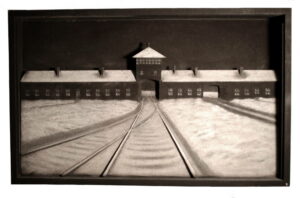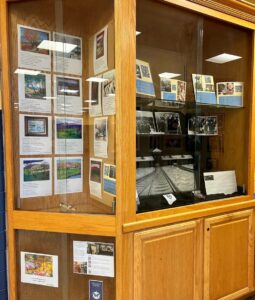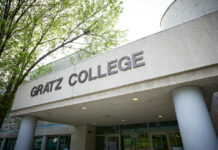
The piece is called “Entrance to Birkenau,” and it shows a snowy train track running through an opening in a dark building and into a vast darkness beyond. It’s enough to send a chill down your spine.
“Entrance to Birkenau,” of course, refers to the most infamous Nazi concentration camp there was: Auschwitz-Birkenau, which was actually “a complex of over 40 concentration and extermination camps” where almost 1 million Jews went to die, according to its Wikipedia page. But this sculpture is not designed to teach you those historical facts.
Instead, it’s built to give you something perhaps more valuable: an impression.
Such is the power of high-quality art. That’s why the Elkins Park-based Holocaust Awareness Museum and Education Center is displaying this sculpture at nearby Cheltenham High School.
In Cheltenham’s main lobby, students can walk up to “Entrance to Birkenau” and see it inside a glass case alongside other Holocaust items. Teachers will hopefully bring students there during class periods starting next year, according to Lise Marlowe, the program and outreach director for the museum. Marlowe coordinated the placement of the piece with Cheltenham Township School District officials. She hopes to organize similar displays at other schools. The Abington School District and the Downingtown Area School District are among local districts that have relationships with the museum, according to Marlowe.
Recent estimates by the Holocaust Survivors’ Rights Authority and the Anti-Defamation League put the number of remaining survivors at less than 200,000 between the United States and Israel. Marlowe said the Holocaust Awareness Museum and Education Center, or HAMEC, used to communicate with 40 survivors. Today, that group is down to five.
It is getting harder to organize visits by survivors to local schools, so Holocaust education needs to take new forms. This effort becomes even more important in an era of rising antisemitism. The ADL recorded more antisemitic incidents in the U.S. in 2022, 3,697, than in any year since it started keeping track in 1979. This spring, a local township that doesn’t even have a synagogue or Jewish Community Center, Tredyffrin, Chester County, has seen swastikas pop up at a shopping center, middle school and neighborhood, among other locations.
Earlier this year, Gratz College and Theatre Ariel organized performances of a play about 10 Holocaust survivors, called “Survivors,” at local schools including in Springfield Township. Christina Photiades, an English teacher at Springfield Middle School, told the Jewish Exponent in April that she hoped her students walked away from the show with “a greater sense of empathy for all of the survivors and victims of the Holocaust.”
A piece of art can have the same impact, according to Marlowe, who is also an elementary school teacher in the Cheltenham district.
“The goal is, since it’s a three-dimensional piece especially, that the kids kind of walk into history,” she said. “They feel like they’re walking through the footsteps of these survivors.”

“Entrance to Birkenau” was created by the late Frank Root, a Philadelphia-based artist who was not Jewish. His wife, Ruth Joray, was, and, at the funeral of her mother, Sadie Silverman, he had a vision. While standing in a cemetery, Root saw a group of people who were bound together ascending. It looked like they had risen from a concentration camp, according to Joray.
After his vision, the artist went to Gratz, looked up images of the Holocaust and became “engrossed,” his wife recalled. He spent the next two decades on about 40 sculptures about the Holocaust, his “Journey into Darkness” series. Joray said the pieces were displayed between 30 and 40 times, and when survivors saw them, they would often approach Root and ask, “How did you know?”
Root died in 2015, and his wife still had the sculptures. She wanted to donate his work so those feelings would live on. But none of the institutions that showcased the artist’s pieces had room for a collection. But then Joray read an article in The Philadelphia Inquirer about Marlowe teaching the Holocaust to her elementary school students.
She reached out to the HAMEC volunteer, who came to her house. Joray invited her into the basement. When they got downstairs, Marlowe saw the pieces and “started crying,” Joray recalled.
HAMEC has 16 other Root sculptures. They are the pieces that Marlowe plans to distribute to local schools. She hopes to get them up by September for the start of the new school year.
“To keep it not just for a week in their minds, but to keep it in their minds hopefully on a daily basis,” Marlowe said of students.






